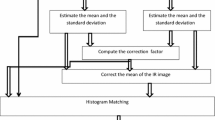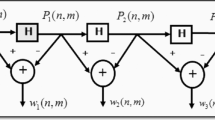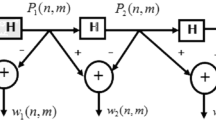Abstract
This paper presents two proposed approaches for enhancing the visibility of the infrared (IR) night vision images. The first approach is based on merging gamma correction with histogram matching (HM). On the other hand, the second approach depends on merging gamma correction with contrast limited adaptive histogram equalization (CLAHE). The HM depends on a reference visual image for converting IR night vision images into images with better visual quality. Quality metrics such as entropy, average gradient, and Sobel edge magnitude are used for performance evaluation of the proposed approaches.






Similar content being viewed by others
References
Ashiba HI, Mansour HM, Ahmed HM, El-Kordy MF, Dessouky MI, El-Samie FEA (2018) Enhancement of infrared images based on efficient histogram processing. Wirel Pers Commun 99:619–636. https://doi.org/10.1007/s11277-017-4958-9
Bai X (2015) Morphological infrared image enhancement based on multi-scale sequential toggle operator using opening and closing as primitives. Infrared Phys Technol 68:143–151
Bai X, Liu H (2017) Edge enhanced morphology for infrared image analysis. Infrared Phys Technol 80:44–57
Balntas V, Johns E, Tang L, Mikolajczyk K (2016) PN-Net: Conjoined triple deep network for learning local image descriptors. CoRR abs/1601.05030
Dai S, Liu Q, Li P, Liu J, Xiang H (2015) Study on infrared image detail enhancement algorithm based on adaptive lateral inhibition network. Infrared Phys Technol 68:10–14
Donahue J, Jia Y, Vinyals O, Ho_man J, Zhang N, Tzeng E, Darrell T (2014) Decaf: A deep convolutional activation feature for generic visual recognition. In:ICLR
Fan B, Kong Q, Trzcinski T, Wang Z, Pan C, Fua P (2014) Receptive _elds selection for binary feature description. IEEE Trans Image Process 23(6):2583–2595
Girshick RB, Donahue J, Darrell T, Malik J (2014) Rich feature hierarchies for accurate object detection and semantic segmentation. In: CVPR
Gonzalez RC, Woods RE (2018) Pearson, Digital Image Processing 4th edition, Prentice Hall
Gupta S, Mazumdar SG (2013) Sobel edge detection algorithm. International Journal of Computer Science and Management Research 2(2):2278–733X
Jung J, Gibson J (2006) The interpretation of spectral entropy based upon rate distortion functions, in IEEE International Symposium on Information Theory, pp. 277–281
Li Y, Zhang Y, Geng A, Cao L, Chen J (2016) Infrared image enhancement based on atmospheric scattering model and histogram equalization. Opt Laser Technol 83:99–107
Liang K, Ma Y, Xie Y, Zhou B, Wang R (2012) A new adaptive contrast enhancement algorithm for infrared images based on double plateaus histogram equalization. Infrared Phys Technol 55:309–315
Liu N, Chen X (2016) Infrared image detail enhancement approach based on improved joint bilateral filter. Infrared Phys Technol 77:405–413
Liu B, Pan J, McKay RI (2009) Entropy-based metrics in swarm clustering. Int J Intell Syst 24:989–1011
Pratt K W (1991). Digital Image Processing, Second Ed. Wiley, New York
Qi W, Han J, Zhang Y, Bai L-f (2016) Infrared image enhancement using cellular automata. Infrared Phys Technol 76:684–690
Raghatate RP, Rajurkar SS, Waghmare MP, Ambatkar PV (2013) Night vision techniques and their applications. International Journal of Modern Engineering Research 3(2):816–820
Saad MA, Bovik AC, Charrier C (2012) Blind image quality assessment: a natural scene statistics approach in the DCT domain. IEEE Transaction on Image Processing 21(8):3339–3352
Simo-Serra E, Trulls E, Ferraz L, Kokkinos I, Fua P, Moreno-Noguer F (2015) Discriminative learning of deep convolutional feature point descriptors. In: ICCV
Song Q, Wang Y, Baia K High dynamic range infrared images detail enhancement based on local edge preserving filter. Infrared Phys Technol. https://doi.org/10.1016/j.infrared.2016.06.023,2016
Thakur P, Thakur RS (2016) An Overview of Various Edge Detection Techniques used in Image Processing, International Journal of innovations in Engineering and technology, 2319–1058
Zeiler MD, Fergus R (2014) Visualizing and understanding convolutional networks. In: ECCV
Zhang S, Li P, Xu X, Li L, Chang CC (2018) No-reference image blur assessment based on response function of singular values. Symmetry 10(304):2–15
Zhao J, Qu S (2011) The fuzzy nonlinear enhancement algorithm of infrared image based on Curvelet transform. Procedia Engineering 15:3754–3758
Author information
Authors and Affiliations
Corresponding author
Additional information
Publisher’s note
Springer Nature remains neutral with regard to jurisdictional claims in published maps and institutional affiliations.
Rights and permissions
About this article
Cite this article
Ashiba, M.I., Tolba, M.S., El-Fishawy, A.S. et al. Gamma correction enhancement of infrared night vision images using histogram processing. Multimed Tools Appl 78, 27771–27783 (2019). https://doi.org/10.1007/s11042-018-7086-y
Received:
Revised:
Accepted:
Published:
Issue Date:
DOI: https://doi.org/10.1007/s11042-018-7086-y




